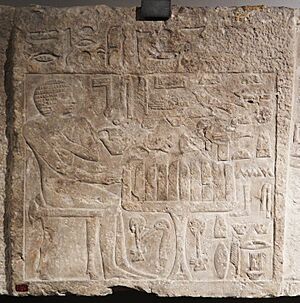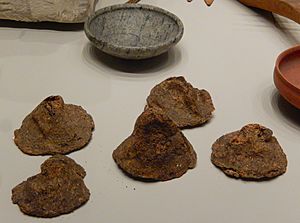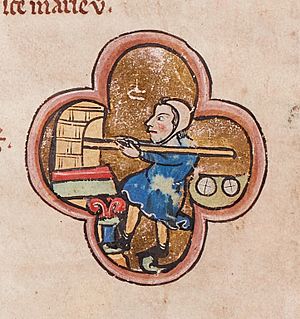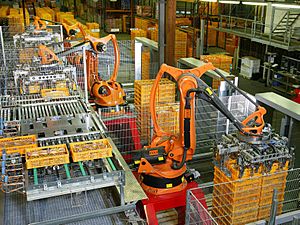History of bread facts for kids
Bread has been super important throughout human history! It helped early human societies grow and change. When people learned to grow wheat in the Fertile Crescent (a region in the Middle East), farming spread across the world. This change meant people could settle down and build towns instead of living as nomads, always moving around. Similar things happened in the Americas with corn and in Asia with rice.
Contents
Ancient Bread Making
Scientists have found really old pieces of flatbread made by Natufian hunter-gatherers. These crumbs, found in Jordan, are between 14,600 and 11,600 years old! They were made from wild wheat, barley, and plant roots. This means people were making bread thousands of years before they started farming wheat. Grinding stones, possibly for flour, have been found from 30,000 years ago in Australia and Europe.
Bread is closely linked to agriculture. Wheat was first grown in the Fertile Crescent. We've found bread at ancient sites in Turkey and Europe from about 9,100 years ago.
There's lots of proof that ancient Egyptians made bread. We see it in their art, find tools they used, and even discover old pieces of dough and bread itself.
In ancient times, people often used a piece of dough from the day before to make new bread rise. This was like a sourdough starter. The ancient writer Pliny the Elder said that people in Gaul (modern France) and Iberia (modern Spain) used foam from beer to make their bread lighter. Other places that drank wine used a paste of grape juice and flour, or wheat bran soaked in wine, to get yeast for rising.
The idea of a special oven that could be heated up, with a door, seems to have come from the Greeks.
Even long ago, there were many kinds of bread. In ancient Greece, barley bread was common. Solon, a Greek leader, said wheat bread should only be for special feast days. By the 400s BC, you could buy bread from bakeries in Athens. Greek bakers came to Rome in the 100s BC. The writer Athenaeus (around 170-230 AD) described many ancient breads, like griddle cakes, honey-and-oil bread, and mushroom-shaped loaves with poppy seeds.
The type of flour also mattered. One writer, Diphilus, said wheat bread was better than barley bread. He also noted that bread made from very fine, sifted flour was the best. Bread was so important that the rest of the meal was called ópson, meaning "bread's accompaniment."
Bread in the Middle Ages
In medieval Europe, bread was not just food. It was also used as a plate! People used a piece of stale bread, called a trencher, about 6 by 4 inches (15 by 10 cm). This bread plate would soak up juices from the food. If food was scarce, people would eat the trencher after their meal. If there was plenty of food, the trenchers might be given to the poor or to dogs. Wooden plates didn't start to replace bread trenchers until the 1400s.
In Britain, laws like the Assize of Bread and Ale (from the 1200s) controlled the price, weight, and quality of bread and beer. These laws slowly disappeared by the early 1800s.
Bread up to the 1800s
The Corn Laws in Britain made bread very expensive. Groups like the Anti-Corn Law League fought for "cheap bread." These laws were mostly removed by 1869, which helped lower bread prices.
From the late 1700s to the late 1800s, bread sold in England and the United States was sometimes mixed with harmful things. These included chalk, sawdust, and clay. Frederick Accum warned people about this in 1820. In 1837, an American health reformer named Sylvester Graham wrote a book about how to make healthy bread at home using unrefined wheat flour. This was a response to the bad bread sold in bakeries.
Governments eventually stepped in to stop this. Britain passed Food Adulteration Acts in 1860 and 1899. It took longer in America because different states had different rules. By the mid-1800s, Britain imported a lot of its wheat for bread from the United States.
Modern Bread Making
Bread making became a big industry in the early 1900s. Otto Frederick Rohwedder invented a machine that could slice bread in 1912. By 1928, he had a machine that both sliced and wrapped bread.
When flour is milled to make white flour, some important nutrients are removed. These include dietary fiber, iron, and B vitamins. Because of this, the U.S. government decided in 1941 that white flour should be fortified (have nutrients added back). This happened because many U.S. military recruits during World War II had nutrient deficiencies.
A big change in the United Kingdom was the Chorleywood bread process, developed in 1961. This method uses strong mixing to make dough quickly. It greatly reduces the time needed for fermentation and for making a loaf of bread. However, some people felt it made the bread lose some taste and nutrition.
For a long time, white bread was seen as food for the rich, while poor people ate dark (whole-grain) bread. But in many Western countries by the late 1900s, this changed. Whole-grain bread became popular because it was seen as healthier. Chorleywood bread, on the other hand, became linked to less healthy eating habits.
Today, especially in smaller bakeries, chemical additives are sometimes used. These can speed up mixing and reduce fermentation time even more. This means a batch of bread can be mixed, shaped, risen, and baked in less than three hours. Dough that doesn't need fermentation because of these additives is sometimes called "quick bread." Common additives include things like ascorbic acid (Vitamin C), which can make wholemeal bread softer. Calcium was added to flour in the UK during World War II to help prevent rickets in women.
Since 1986, home breadmakers have become popular. These machines automate the whole process of making bread at home.
See also
 In Spanish: Historia del pan para niños
In Spanish: Historia del pan para niños






